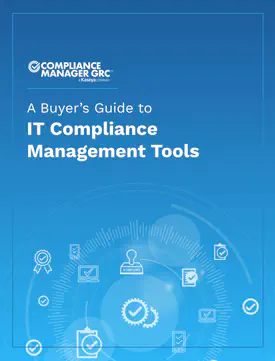The need for powerful and multilayered cybersecurity in today’s threat landscape is dire. To say it’s difficult to implement the latest threat management strategies is an understatement, especially for organizations involved with the U.S. Department of Defense (DoD).
This blog explores the Cybersecurity Maturity Model Certification (CMMC), a framework ensuring that DoD contractors have the necessary cybersecurity measures in place. We’ll delve into why this certification is essential, who needs it, how it operates and how tools like Compliance Manager GRC can enhance your CMMC compliance journey.
What is CMMC?
The Cybersecurity Maturity Model Certification (CMMC) is a regulatory framework designed to ensure that all contractors within the Defense Industrial Base (DIB), including subcontractors, meet specific cybersecurity thresholds. The model is crucial for protecting Controlled Unclassified Information (CUI) and Federal Contract Information (FCI) — crucial data types that, if compromised, could pose significant risks to national security.
Recent statistics indicate a concerning trend. Approximately 78% of DIB contractors fail to meet the basic cybersecurity requirements set forth by the Federal Acquisition Regulation (FAR) Clause 52.204-21. This highlights the urgent need for enhanced training and proactive measures to align these entities with the CMMC’s stringent standards.
The CMMC framework has also expanded its scope to include compliance as well as proactive defense, threat intelligence sharing and robust incident response strategies. These measures are essential for contractors to maintain a vigilant and adaptive security posture, allowing them to quickly respond to new cyberthreats and vulnerabilities that could jeopardize national security.
The CMMC is more than just a regulatory requirement; it is an integral component of national defense strategy against cyberthreats. By understanding and implementing the robust standards of the CMMC, contractors and subcontractors in the DIB can enhance their cybersecurity posture, ensuring the protection of sensitive data and infrastructure.
What is the current version of the CMMC?
Introduced to streamline the original complex framework and make it more accessible for small and midsized businesses, CMMC 2.0 simplifies the requirements while maintaining rigorous cybersecurity standards essential for the defense sector’s integrity.
CMMC 1.0
This initial version established a tiered cybersecurity framework encompassing five levels, each with increasingly stringent security requirements. It was designed to progressively enhance the cybersecurity posture of all defense contractors through standardized practices and procedures.
CMMC 2.0
Introduced in November 2021, CMMC 2.0 marked a significant evolution of the certification process, offering a balanced approach between rigorous third-party assessments and self-assessments. This update aims to lessen the compliance burden, particularly for smaller contractors, without compromising the high standards necessary for securing the defense supply chain. Moreover, CMMC 2.0 extends the requirement of compliance to include not only prime contractors but also subcontractors and suppliers, emphasizing the importance of securing every tier of the supply chain against potential breaches, as evidenced by incidents like the SolarWinds hack.
Responding to industry feedback, CMMC 2.0 reduces the five levels to three, focusing on scalability and economic efficiency. It retains the core security objectives but with streamlined requirements that lower the compliance burden, particularly on smaller organizations within the defense sector.
Why is the CMMC important?
The CMMC will become a compulsory requirement for all DoD contracts by 2026, reflecting its critical role in safeguarding sensitive government data. This forward-looking approach ensures that all entities in the defense supply chain implement robust cybersecurity measures to protect against both current and emerging cyberthreats.
Who needs CMMC compliance?
All entities involved with the DoD, from primary contractors to smaller subcontractors, are required to obtain CMMC certification. This broad applicability ensures that every link in the defense supply chain is secure, protecting essential operations from potential cybersecurity threats.
What is the CMMC framework?
The CMMC’s framework is designed as a comprehensive set of cybersecurity standards that encompass various aspects of an organization’s security posture.
Domains
Domains are categories of cybersecurity concerns, such as Access Control and Incident Response, that structure the specific practices and policies an organization must implement.
Practices
These are specific actions within each domain that organizations must perform to demonstrate compliance at various certification levels, from basic cyber hygiene to advanced cybersecurity measures.
Processes
Processes evaluate how well an organization integrates and adheres to cybersecurity practices over time, focusing on the maturity and institutionalization of those practices.
Levels
Each level represents a step in cybersecurity maturity, from basic to advanced protections, dictating the depth and rigor of security practices that must be demonstrated.
Assessments
Assessments are evaluations that determine if an organization meets the required level of cybersecurity maturity, involving self-assessments or reviews by certified third-party assessors, depending on the level.
What are the three levels of CMMC?
CMMC 2.0 categorizes cybersecurity maturity into three distinct levels, each reflecting a stage of sophistication in protecting sensitive government data.
Level 1: Foundational
It represents basic cyber hygiene practices that serve as the foundation for protecting Federal Contract Information (FCI) against common data breaches.
Level 2: Advanced
It includes a comprehensive set of security measures designed to protect Controlled Unclassified Information (CUI), which requires more sophisticated policies and practices.
Level 3: Expert
At this highest level, organizations must demonstrate capabilities to protect CUI from Advanced Persistent Threats (APTs), which involve complex security practices and significant organizational commitment to cybersecurity.
Meet CMMC requirements with Compliance Manager GRC
Compliance Manager GRC is here to help you meet all levels of CMMC compliance. It keeps track of all of your IT requirements, highlights issues that may need attention and makes it easy to generate reports and evidence of compliance with CMMC standards.
For a deeper understanding of how Compliance Manager GRC can support your compliance journey, watch our webinar, Master Class: Provide CMMC Compliance-as-a-Service, or see it in action by scheduling a demo today.
